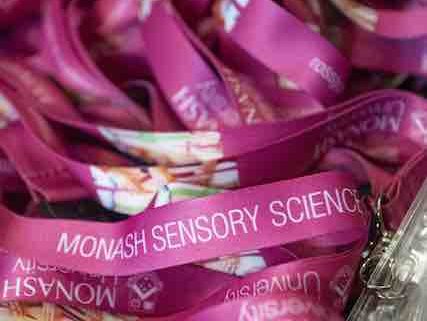Monash Sensory Science Exhibition brings art and science together for diverse needs participants
Activating art and technology to explore the science of autoimmunity, the Monash Biomedicine Discovery Institute hosted a free sensory exhibition on Friday 30 June, curated specifically for blind, low-vision and diverse needs audiences.
Designed for all ages and levels of science literacy, the Monash Sensory Science Exhibition – Autoimmunity explored eight autoimmune diseases through multi-sensory, multi-modal artworks and tactile displays, offering an accessible and inclusive learning opportunity.

Sensory Science in action.
From handcrafted immune cells made of clay, food, paper and fabrics, to technologies and interactive displays exploring autoimmune processes, participants learned about the ways in which the body mistakenly attacks its own organs and tissues, resulting in health conditions such as type 1 diabetes, multiple sclerosis and celiac disease.

Dr Stuart Favilla, Dr Erica Tandori, Professor Jamie Rossjohn, Dr Carina Garland MP, Professor Christina Mitchell AO and Dr Lisa Ciacchi.
Held in the award-winning Learning and Teaching Building on the Monash Clayton campus, participants heard from Professor Jamie Rossjohn, a Monash University T cell immunology expert, then chose from sessions exploring various diseases in depth. Dr Carina Garland MP, Federal Member for Chisholm, also attended the event’s opening address.
Professor Rossjohn said that autoimmune disorders impacted about five per cent of the population, with more women generally affected than men. The exhibition provided an opportunity for awareness-raising through a highly creative and dynamic experience.
“I’m delighted to have taken part in the Monash Sensory Science Exhibition,” he said. “It was a valuable opportunity to share information and learnings on autoimmunity, the body and how researchers are working to find better treatment options and cures.”

Hairy leukemia interactive chess pieces.
Supported by volunteers, over 100 participants learned through handling artworks, touching tactile displays and hearing research experts on the topic.
First held in 2018, the exhibition is an initiative of the Rossjohn Laboratory, a research group pursuing the advancement of knowledge of innate and adaptive immunity, led by Professor Rossjohn. Dr Erica Tandori, a legally blind artist, researcher and academic and the artist-in-residence in the Rossjohn Laboratory, has led the development of the artworks and displays.
Dr Tandori said that the exhibition provided a unique opportunity for participants to explore science through the power of art. “Scientists already use art to make medical concepts tangible and tactile without even realising, such as when they create 3D models of organs or cells,” she said.
“In our exhibition, we’re celebrating and highlighting the unique way in which art can make science accessible to people with different learning needs, and especially to blind and low vision audiences who face multiple barriers to participation. Everybody has a right to know how their bodies work, and to enjoy the opportunity to learn about science in ways that suit their needs.


